
Impressions from the Bratschistentag at Trossingen 2016 |
by Cornelia Brányik and Carlos María Solare
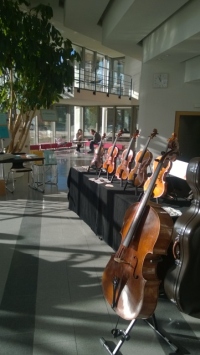 Cornelia Brányik: When I tell my non-musical friends that I have just come back from a viola congress, they usually look at me questioningly. What can that be? I claim that it is an addictive event, and that it creates the greatest expectations for the following one. It is a successful combination of musical highlights, pedagogical and musicological sessions and – not to be forgotten – personal encounters. One finds oneself having lunch with Bruno Giuranna, asking other famous soloists for an autograph, or sharing a nightcap with the luthiers.
Cornelia Brányik: When I tell my non-musical friends that I have just come back from a viola congress, they usually look at me questioningly. What can that be? I claim that it is an addictive event, and that it creates the greatest expectations for the following one. It is a successful combination of musical highlights, pedagogical and musicological sessions and – not to be forgotten – personal encounters. One finds oneself having lunch with Bruno Giuranna, asking other famous soloists for an autograph, or sharing a nightcap with the luthiers.The Bundesakademie für musikalische Jugendbildung (Federal Academy for the Musical Education of the Young) in Trossingen is an ideal location for such an event, idyllically situated and with a kitchen staff that have obviously made their passion into a profession. Already upon arrival one found several sheet music dealers that had set up shop in the foyer with a varied selection of viola literature, and one was well advised to make a quick choice. Those left with empty hands obtained in a neighbouring stand interesting insights about the new website Music4Viola, a programme with comfortable search functions for musical literature and its resources.
It was worth being introduced to the German Viola Society’s new website, which not only has an appealing new logo but has become more alive. Concert organizers can now upload information about their events and promote
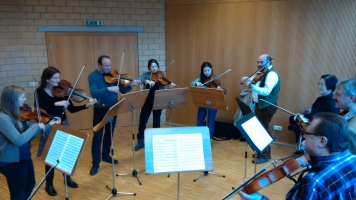 them; after being “rubberstamped” by the webmaster, the information is sent out to the membership by e-mail. Hopefully many people will take advantage of this offer.
them; after being “rubberstamped” by the webmaster, the information is sent out to the membership by e-mail. Hopefully many people will take advantage of this offer.Early-morning ensemble playing is an iconic part of each congress. One never knows who will show up, but there is music for every combination. This time we had a reliable decet led by our President, Ms. Hideko Kobayashi, and consisting of a few theatre musicians and enthusiastic amateurs. To our great fortune, Oliver Tepe was among us and had brought a huge heap of music which he had arranged. The music can be obtained through Music4Viola. These events are also a place for sharing sheet music.
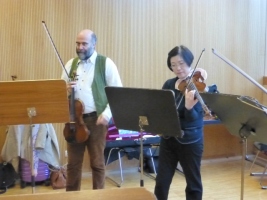 Neither should one miss the opportunity of trying out the instruments on display. Seldom are so many luthiers from far and wide united in one spot, thus allowing for direct comparisons. Although it would be easy to be intimidated by the violin professor who is trying out runs from the Tchaikovsky concerto at the adjoining table, once you take the plunge, the inhibition threshold sinks fast. You find a favourite, someone else drops by, giving you the chance of hearing the viola from outside – thus one learns about the present state of the market for really excellent new instruments.
Neither should one miss the opportunity of trying out the instruments on display. Seldom are so many luthiers from far and wide united in one spot, thus allowing for direct comparisons. Although it would be easy to be intimidated by the violin professor who is trying out runs from the Tchaikovsky concerto at the adjoining table, once you take the plunge, the inhibition threshold sinks fast. You find a favourite, someone else drops by, giving you the chance of hearing the viola from outside – thus one learns about the present state of the market for really excellent new instruments.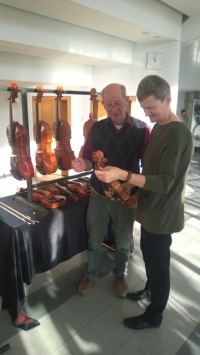 In between some quality concerts there were chances to widen one’s horizon in various lectures, e.g. about stage fright – and one kept coming back to Bartók. As Prof Roland Glassl observed in his master class, every violist should own a copy of the manuscript sketches of the viola concerto, which can now be officially downloaded from the internet. A group of fascinated
In between some quality concerts there were chances to widen one’s horizon in various lectures, e.g. about stage fright – and one kept coming back to Bartók. As Prof Roland Glassl observed in his master class, every violist should own a copy of the manuscript sketches of the viola concerto, which can now be officially downloaded from the internet. A group of fascinated 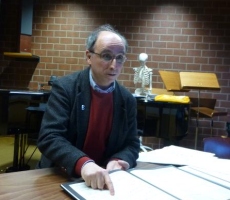 listeners sits around a beautifully bound facsimile and listens to Carlos Solare’s remarks about the genesis, structure and orchestration of this concerto that was unfortunately left unfinished at the composer’s death. We inspect Bartók’s scribbled figures: some of them are indications about the duration of the various parts, but others turn out to be the documentation of the terminally ill composer’s fever, notated in both Celsius and – since he was living in the USA – also in Fahrenheit. What did we learn? Although Bartók described his concerto in a letter as being “ready in draft”, we can only surmise how he really imagined the finished piece. A large part of the sketches includes just the solo part with hardly any clues as to the shape of the accompaniment. Apart from the well-known realisation by Tibor Serly, which allowed the concerto to achieve a central position within the viola repertoire, there are now a few others that diverge widely in many places. Irrespectively of which one is preferred, all of them can only be attempts to illuminate an actually unsolvable enigma.
listeners sits around a beautifully bound facsimile and listens to Carlos Solare’s remarks about the genesis, structure and orchestration of this concerto that was unfortunately left unfinished at the composer’s death. We inspect Bartók’s scribbled figures: some of them are indications about the duration of the various parts, but others turn out to be the documentation of the terminally ill composer’s fever, notated in both Celsius and – since he was living in the USA – also in Fahrenheit. What did we learn? Although Bartók described his concerto in a letter as being “ready in draft”, we can only surmise how he really imagined the finished piece. A large part of the sketches includes just the solo part with hardly any clues as to the shape of the accompaniment. Apart from the well-known realisation by Tibor Serly, which allowed the concerto to achieve a central position within the viola repertoire, there are now a few others that diverge widely in many places. Irrespectively of which one is preferred, all of them can only be attempts to illuminate an actually unsolvable enigma.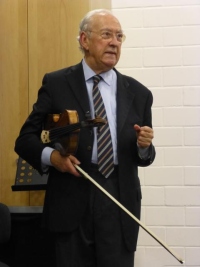 Carlos María Solare: As with the Bartók concerto, albeit of course for completely different reasons, the sonatas by Johannes Brahms are another “problem child” of the viola repertoire. Whether to stick to the composer-approved viola version – which he notoriously described as “awkward and unsatisfying” – or go back to the original clarinet version is a question that has preoccupied us all for as long as the two pieces have been in existence. In his keynote lecture on Friday evening, Prof Bruno Giuranna reviewed the sources and demonstrated with the help of numerous short examples the advantages and disadvantages of both versions. He was thereby supported by Giacometta Marrone d’Alberti, the wife of congress host, James Creitz. The lecture ended with a complete performance of the F minor sonata by both artists. Afterwards I (CMS) mentioned to Mr Giuranna that back when I had the privilege of working with him, he preferred different solutions for some of the passages in question. In his inimitable, amused-ironic way, he answered: “I reserve the right to change!”
Carlos María Solare: As with the Bartók concerto, albeit of course for completely different reasons, the sonatas by Johannes Brahms are another “problem child” of the viola repertoire. Whether to stick to the composer-approved viola version – which he notoriously described as “awkward and unsatisfying” – or go back to the original clarinet version is a question that has preoccupied us all for as long as the two pieces have been in existence. In his keynote lecture on Friday evening, Prof Bruno Giuranna reviewed the sources and demonstrated with the help of numerous short examples the advantages and disadvantages of both versions. He was thereby supported by Giacometta Marrone d’Alberti, the wife of congress host, James Creitz. The lecture ended with a complete performance of the F minor sonata by both artists. Afterwards I (CMS) mentioned to Mr Giuranna that back when I had the privilege of working with him, he preferred different solutions for some of the passages in question. In his inimitable, amused-ironic way, he answered: “I reserve the right to change!”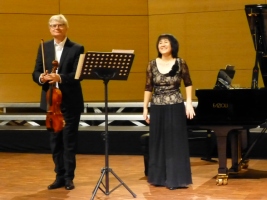 Later that evening, Prof Hariolf Schlichtig performed with pianist Yumi Sekiya the sonatas for viola (da gamba) in G major and G minor by Johann Sebastian Bach and the sonata in B flat major Op. 107 by Max Reger. This is – like the Brahms sonatas – a clarinet piece that was arranged for viola by the composer. However, in this case there was no need to worry about different versions, and one could just admire the two completely different kind of sound that Mr Schlichtig found for these composers’ music. He did employ two bows, but one could be forgiven for thinking that had swapped instruments as well: the low-lying viola part of the Bach sonatas was played with “al fresco” ruggedness, while in the soaring lines of Reger’s work the sound was comparable to a clarinet’s velvet-like tonal qualities.
Later that evening, Prof Hariolf Schlichtig performed with pianist Yumi Sekiya the sonatas for viola (da gamba) in G major and G minor by Johann Sebastian Bach and the sonata in B flat major Op. 107 by Max Reger. This is – like the Brahms sonatas – a clarinet piece that was arranged for viola by the composer. However, in this case there was no need to worry about different versions, and one could just admire the two completely different kind of sound that Mr Schlichtig found for these composers’ music. He did employ two bows, but one could be forgiven for thinking that had swapped instruments as well: the low-lying viola part of the Bach sonatas was played with “al fresco” ruggedness, while in the soaring lines of Reger’s work the sound was comparable to a clarinet’s velvet-like tonal qualities.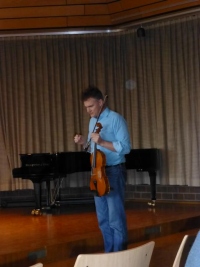 The events of the two following days took place in the Hochschule für Musik. A concert of the Hochschule Orchestra on Saturday night had Prof Roland Glassl as the soloist in Hindemith’s “Der Schwanendreher”, which he performed with his personal blend of passion and intellect. Led by Prof Sebastian Tewinkel, the orchestra accompanied him sensitively and with a transparent sound that allowed for the viola to be clearly heard even in the loudest passages. It was encouraging to note the presence in the audience of the city’s mayor and a former governor of Baden-Württemberg, who are both actively engaged in the city’s cultural life.
The events of the two following days took place in the Hochschule für Musik. A concert of the Hochschule Orchestra on Saturday night had Prof Roland Glassl as the soloist in Hindemith’s “Der Schwanendreher”, which he performed with his personal blend of passion and intellect. Led by Prof Sebastian Tewinkel, the orchestra accompanied him sensitively and with a transparent sound that allowed for the viola to be clearly heard even in the loudest passages. It was encouraging to note the presence in the audience of the city’s mayor and a former governor of Baden-Württemberg, who are both actively engaged in the city’s cultural life.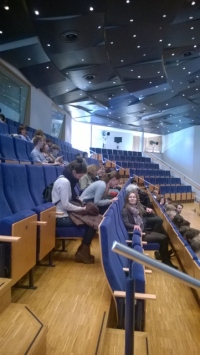 Unfortunately, many participants had to leave before the concluding concert on Sunday noon. Those who could stay experienced an exquisite concert with the string quintets K 406 in C minor by Mozart and Op. 111 in G major by Brahms. Professors Winfried Rademacher (Violin), Hariolf Schlichtig (Viola) and Francis Gouton (Cello), supported by Elsa Klockenbring and Tobias Reifland in the second parts, regaled us with two finely sculpted readings that were subsequently discussed during the long train ride back home. This 28th Bratschistentag was a successful event thanks to the untiring efforts of the DVG presidents and the local hosts. Heartfelt thanks are due to Prof Hideko Kobayashi, Prof Elisabeth Gutjahr, Dr Peter Gries and Prof James Creitz.
Unfortunately, many participants had to leave before the concluding concert on Sunday noon. Those who could stay experienced an exquisite concert with the string quintets K 406 in C minor by Mozart and Op. 111 in G major by Brahms. Professors Winfried Rademacher (Violin), Hariolf Schlichtig (Viola) and Francis Gouton (Cello), supported by Elsa Klockenbring and Tobias Reifland in the second parts, regaled us with two finely sculpted readings that were subsequently discussed during the long train ride back home. This 28th Bratschistentag was a successful event thanks to the untiring efforts of the DVG presidents and the local hosts. Heartfelt thanks are due to Prof Hideko Kobayashi, Prof Elisabeth Gutjahr, Dr Peter Gries and Prof James Creitz.• GermanViola Society: http://www.viola-gesellschaft.de/
• Amadeus Publisher: http://www.amadeusmusic.ch/
• Viola Store: http://www.violastore.de/
• Albrecht Löbner - Violin- und Viola builder: http://www.geigenbau-loebner.de/
• Wolfram Neureither - Viola builder: http://www.neureither-luthier.com/
• Haat-Hedlef Uilderks - Violin builder: http://www.geigenbauonline.de/
Hideko Kobayashi wrote on 21.01.2017 at 10:57
The next Bratschistentag will take place from 27.10.17 to 29.10.17 in Wiesbaden, Germany. You are all very welcome!
Silvia Matile wrote on 18.01.2017 at 17:49
When will the next Bratschentag be?
| Blog overview |
» To the blog list
| Newsletter |
 Do you don't want to miss any news regarding viola anymore? Our newsletter will keep you informed.
Do you don't want to miss any news regarding viola anymore? Our newsletter will keep you informed.» Subscribe to our Newsletter for free
 Visit us on Facebook. The news articles are also posted.
Visit us on Facebook. The news articles are also posted.» To Facebook